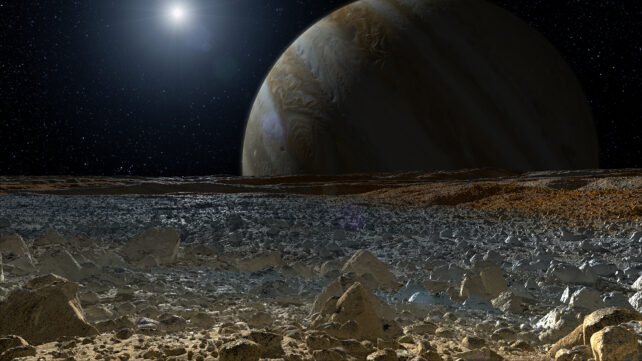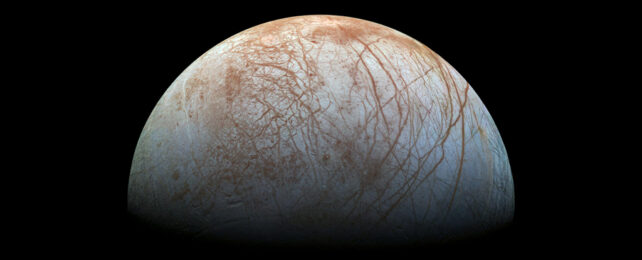Europa is the smoothest solid object in our Solar System, thanks to its thick shell of ice. Yet beneath its smooth exterior, Jupiter's fourth-largest moon seems to harbor secrets – namely a deep, salty ocean with intriguing potential for alien life.
That ocean makes Europa a prime target for scientific study, including two separate orbiter missions set to launch toward Jupiter over the next two years.
And while it will take several years for either probe to arrive, scientists are already shedding light on Europa in other ways, gleaning insights from telescope observations, previous probe flybys, lab experiments, and computer simulations.
In a new study, researchers from the Jet Propulsion Laboratory (JPL) at the California Institute of Technology in the US and Hokkaido University in Japan used NASA supercomputers to examine a lesser-known quirk of Europa: Why does the ice shell rotate faster than the interior?
According to their research, the surface's out-of-sync rotation might be caused by ocean currents pushing from below. That's a big revelation, explains lead author and JPL researcher Hamish Hay, now at the University of Oxford; it's a revelation that could offer new clues about what's going on under there.
"Before this, it was known through laboratory experiments and modeling that heating and cooling of Europa's ocean may drive currents," Hay says. "Now our results highlight a coupling between the ocean and the rotation of the icy shell that was never previously considered."

The ice shell floats on Europa's ocean, so it can rotate independently from the rest of the moon, including the ocean, rocky interior, and metallic core. Scientists have long suspected this, but the forces driving the shell's rotation have been mysterious.
Europa is subject to tidal flexing by Jupiter, which distorts the moon through its powerful gravitational pull. This colossal tug-of-war causes cracks in Europa's ice shell and likely generates a portion of the mantle's and core's heat.
Together with thermal energy released from radioactive decay, this warmth from Europa's interior is thought to rise through the ocean toward the frozen surface like a pot of water heating on a stove.
Combined with Europa's rotation and other factors, that vertical temperature gradient ought to fuel some fairly powerful ocean currents.
And according to estimates in the study, those currents could be powerful enough to move the global ice shell overhead. No one knows exactly how thick the shell is, but estimates range from about 15 to 25 kilometers (15 miles) thick.
While scientists knew Europa's ice shell likely rotates on its own, they had focused on Jupiter's gravitational influence as the driving force.
"To me, it was completely unexpected that what happens in the ocean's circulation could be enough to affect the icy shell. That was a huge surprise," says study co-author and Europa Clipper Project scientist Robert Pappalardo, of NASA's Jet Propulsion Lab.
"And the idea that the cracks and ridges we see on Europa's surface could be tied to the circulation of the ocean below – geologists don't usually think, 'Maybe it's the ocean doing that,'" he adds.
The researchers used NASA supercomputers to build complex simulations of Europa's ocean, borrowing techniques that have been used to model oceans on Earth.
These models let them delve deeper into the details of water circulation on Europa, including how those patterns are influenced by the heating and cooling of the ocean.
A key focus of the study was drag, or the horizontal force of the ocean pushing the ice above it. By factoring drag into their simulations, the researchers found some faster currents could produce enough drag to speed up or slow down the rotation of Europa's ice shell.
While that effect depends on the speed of currents, the researchers note Europa's internal heating may vary over time. That could lead to corresponding variation in the speed of ocean currents, in turn causing faster or slower rotation of the ice shell.
Beyond helping us understand Europa, this research may also apply to other ocean worlds, the researchers point out, where surface features could offer hints about waters hidden below.
"And now that we know about the potential coupling of interior oceans with the surfaces of these bodies, we may learn more about their geological histories as well as Europa's," Hay says.
The ESA's Jupiter Icy Moons Explorer (JUICE) is slated to launch in April 2023, beginning its voyage to study Jupiter's three large, ocean-bearing moons: Ganymede, Callisto, and Europa.
In late 2024, NASA plans to launch its Europa Clipper orbiter, which will perform nearly 50 close flybys to investigate the moon's potential habitability. According to the authors of the new study, it might even be able to precisely measure how quickly Europa's ice shell is rotating.
The study was published in JGR Planets.
